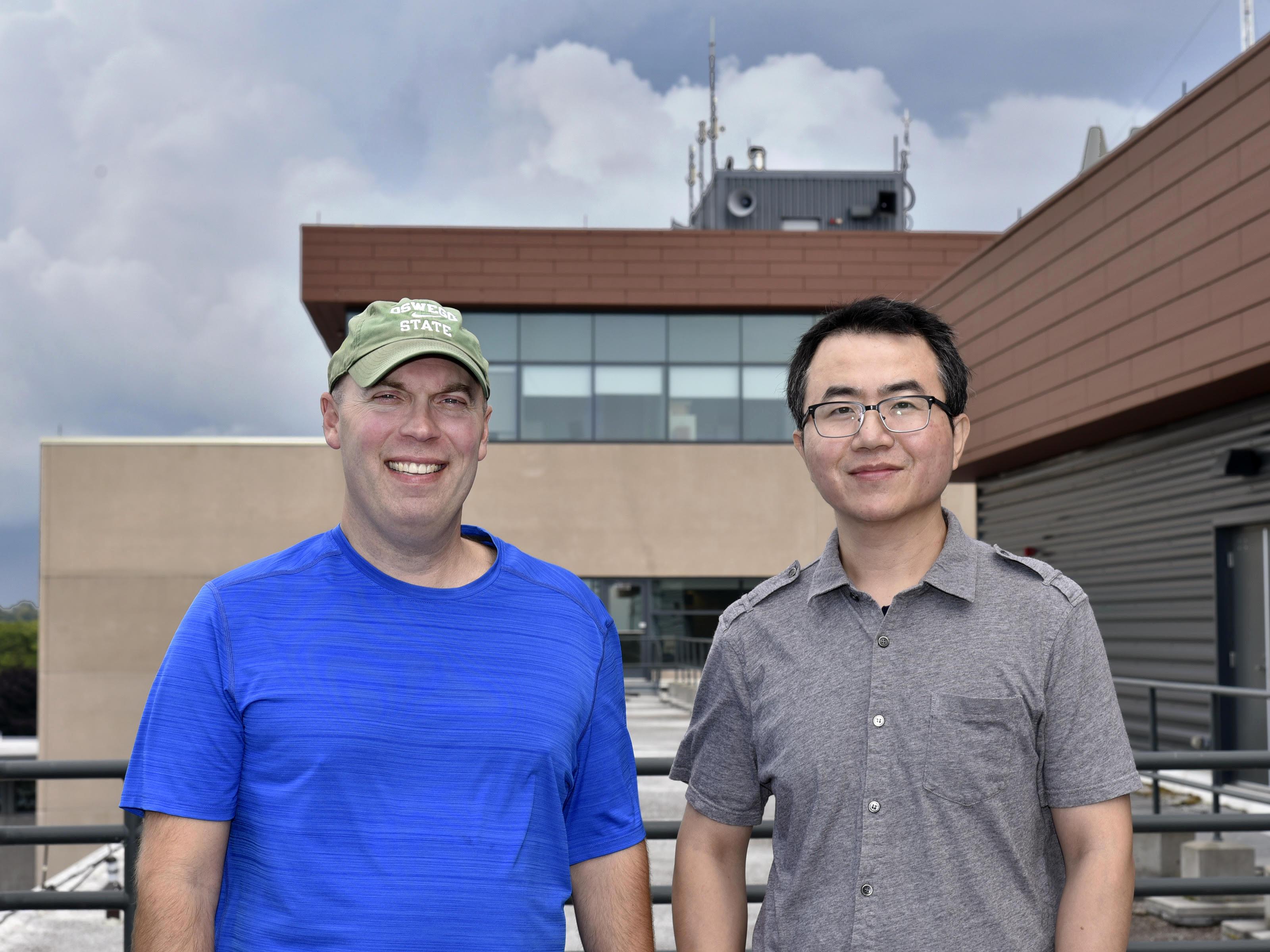Meteorology faculty Scott Steiger and Yonggang Wang lead a more than $1 million project, funded by the National Science Foundation, titled Lake-Effect Electrification and the Impacts of Wind Turbines on Electrification East of Lake Ontario.”
Two SUNY Oswego faculty members are working with 22 students to take part in a federally funded project to study extreme lake-effect phenomena.
Meteorology faculty Scott Steiger and Yonggang Wang lead a more than $1 million project, funded by the National Science Foundation (NSF), titled "Lake-Effect Electrification (LEE) and the Impacts of Wind Turbines on Electrification East of Lake Ontario.”
Those funds will pay student researchers as well as bring in a Doppler on Wheels mobile unit from the University of Illinois to provide an up-close, state-of-the-art experience for students, with the project running from this September into March 2023.
“The frequent lake-effect snowstorms in this area produce several thundersnow events each year, and this project will make the first-ever measurements of the electrical structure of lake-effect snow clouds and infer how lightning within them is related to precipitation processes in the clouds,” the project proposal explained.
Steiger said the grant follows up a large-scale NSF-sponsored project among several universities known as the Ontario Winter Lake-effect Systems (OWLeS) project in 2013-14. Consistent with the scientific method, researchers saw something unexpected while observing lake-effect lightning and decided it merited further study.
“Part of that project involved studying lightning in lake-effect events, and under what conditions the lightning develops,” Steiger explained. “What we found quite interesting, and what we didn’t expect, was that all the lightning was inland. Previous lightning climatologies have shown a lot of lightning normally happens over the lake during lake-effect storms, where the greater heat and moisture is.”
Meteorology faculty member Robert Ballentine, who has since retired, made the connection that the lightning strikes occurred around Maple Ridge Wind Farm in what was “just a lightbulb moment,” Steiger recalled.
“We did some more research and presented a paper about how the lightning climatology during the winter storms has shifted from over the lake to now closer to the wind turbines, so a big part of this project is to try and understand what's going on in the clouds, in terms of the electrical charge regions, where they are setting up and how those charge regions interact with the wind turbines to produce lightning,” Steiger noted.
Generating understanding
“This is a pretty big problem across the country with wind turbines getting hit by lightning so it makes sense from a societal aspect to study these lightning events,” he added. Damage to wind turbines can impact the energy grid and the costs of generation, and the Tug Hill region and its wind farms provide a natural laboratory to study this phenomenon.
Wang actually worked on part of the previous OWLeS study with partner institution the University of Wyoming, so that when he joined the Oswego faculty in fall 2020, he had some familiarity with the project.
“I was excited to get back into this activity,” he said.
The new project involves complex modeling and will incorporate lab work and field work, Wang said.
“We have an in-house research and forecasting model we are going to run in a very fine resolution in covering Lake Ontario and also upstate New York, so that it can aid in determining the intensity of these storms,” Wang said.
“There are limitations to operational models and their resolution might not be good enough in focusing on the location and intensity, so we wanted to run our own model and we are going to have maybe a couple more students help with the interpretation of model output, or maybe use unique data software to do the analysis,” Wang said. “After collecting that data, we are going to run some electrification models, so that we can compare what we observed in our field campaign with our models.”
“This will be the first time we see how electrification takes place in lake-effect clouds,” Steiger said. “There’s no other study in the world we know of that does that.”
The project involves deploying about 20 sensors around the Tug Hill region and launching weather balloons, which began in September. All the instruments, including the Doppler on Wheels, will arrive by Nov. 1 in advance of winter lake-effect storm season.
“Three or four lake-effect storms that make lightning would help” make the project successful, Steiger said, but added: “The ultimate success is that everyone stays safe. We’ll have training sessions beforehand, and make sure all of the equipment is working.”
Ultimately, Steiger and Wang noted, the project is about pursuing answers to weather mysteries and preparing students for futures in the field of meteorology.
“Something I’ve always believed in is to give these students opportunities that I wish I had,” Steiger said. “It opens up a lot of doors when you have these experiences.”
Students interested in potentially joining the research team should email scott.steiger@oswego.edu or yonggang.wang@oswego.edu.




